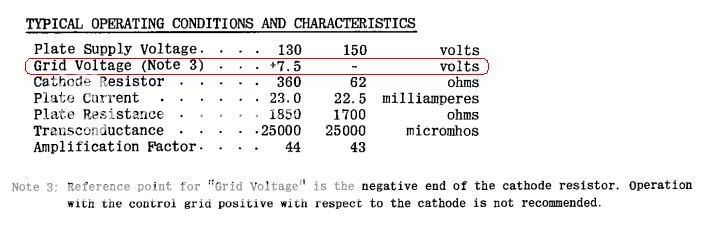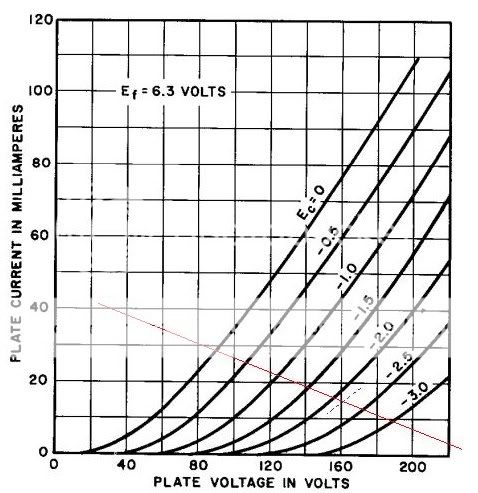Hi there,
I've been playing around the operation points of my Euridice pre these days.
Previoulsy, I ran the tubes on around 135V on anode & 1.2V cathode bias to get 24~25mA.
Recently, I raised the Va to 160V & 2.1~2.2V cathode bias to get 17~18mA.
I found the latter is more open & dynamic. Extremely extended on high & lots of lots of details. In good recordings, cymbals are so sparkling & the decay is so airy. The textures & overtones of acoustic instruments are fabulous. Bad thing is, it reveals more shortcomings on bad recordings & let them sound even worse, especially the mid-high harshness.
Meantime, I rechecked the datasheets, & found something I can not put together.
This is digested from the datasheet of WE417A:

How strange is that!
The note says it's the voltage across grid & "negative" end of cathode resistor. But how is that possible? +7.5V !!
On the datasheet of Raytheon, there's even more, Va=130V, Rcathode=360R, Va=27mA, Vg=+9V !!
Can anyone explain it to me?
Thanks a lot!
The curves:

This is my setting presently, load line is 5K, -2.2V on grid is obtained from red LED on cathode. Actually I got slightly more current than the diagram is shown. I'm not sure how much difference would be among different brands of tubes. I don't have WE yet. Under the same voltages, Amperex flows even more than Raytheon. And the Raytheon actually flow more than WE datasheet....
How do you setup your 417/5842? And how do you like them?
I always read here & there that the WE tube is MUCH superior than others. How true is that?
Call me deaf, I confess, those different brands of tubes in the same type sound very similar to me. I have to listen very hard to tell the subtle differnces. Sometimes, maybe the so-called differences are just my own imaginations, as I'm continuously hinted by myself.
By contrast, different operation points sound much much more significant to me. As in the speaker tunings, I don't play with cables or different brands of caps, I change the parts' values to alter the response... Well, that's me.
Back to the 5842/417A, I'm told the Amperex is superior to Raytheon. My feeling is, well, maybe, but the difference is subtle. Nothing wrong with Raytheon, they sound very good, too.
I'm told the WE is excellent in the mid-high. But how much more? How airy? Into the edge of atmasphere & outer space? I can only imagine until I get them....
I've been playing around the operation points of my Euridice pre these days.
Previoulsy, I ran the tubes on around 135V on anode & 1.2V cathode bias to get 24~25mA.
Recently, I raised the Va to 160V & 2.1~2.2V cathode bias to get 17~18mA.
I found the latter is more open & dynamic. Extremely extended on high & lots of lots of details. In good recordings, cymbals are so sparkling & the decay is so airy. The textures & overtones of acoustic instruments are fabulous. Bad thing is, it reveals more shortcomings on bad recordings & let them sound even worse, especially the mid-high harshness.
Meantime, I rechecked the datasheets, & found something I can not put together.
This is digested from the datasheet of WE417A:

How strange is that!
The note says it's the voltage across grid & "negative" end of cathode resistor. But how is that possible? +7.5V !!
On the datasheet of Raytheon, there's even more, Va=130V, Rcathode=360R, Va=27mA, Vg=+9V !!
Can anyone explain it to me?
Thanks a lot!
The curves:

This is my setting presently, load line is 5K, -2.2V on grid is obtained from red LED on cathode. Actually I got slightly more current than the diagram is shown. I'm not sure how much difference would be among different brands of tubes. I don't have WE yet. Under the same voltages, Amperex flows even more than Raytheon. And the Raytheon actually flow more than WE datasheet....
How do you setup your 417/5842? And how do you like them?
I always read here & there that the WE tube is MUCH superior than others. How true is that?
Call me deaf, I confess, those different brands of tubes in the same type sound very similar to me. I have to listen very hard to tell the subtle differnces. Sometimes, maybe the so-called differences are just my own imaginations, as I'm continuously hinted by myself.
By contrast, different operation points sound much much more significant to me. As in the speaker tunings, I don't play with cables or different brands of caps, I change the parts' values to alter the response... Well, that's me.
Back to the 5842/417A, I'm told the Amperex is superior to Raytheon. My feeling is, well, maybe, but the difference is subtle. Nothing wrong with Raytheon, they sound very good, too.
I'm told the WE is excellent in the mid-high. But how much more? How airy? Into the edge of atmasphere & outer space? I can only imagine until I get them....
a) diyAudio CCS @ 10mA and Orange LEDHow do you setup your 417/5842? And how do you like them?
b) plate choke and Orange LED (~10mA)
Obviously, I like them at that current
c) 5K load, 20mA spud amp configuration.
I like it too.
Superior in what sense?I always read here & there that the WE tube is MUCH superior than others. How true is that?
Agree.By contrast, different operation points sound much much more significant to me. As in the speaker tunings, I don't play with cables or different brands of caps, I change the parts' values to alter the response... Well, that's me.
Back to the 5842/417A, I'm told the Amperex is superior to Raytheon. My feeling is, well, maybe, but the difference is subtle. Nothing wrong with Raytheon, they sound very good, too.
I'm told the WE is excellent in the mid-high. But how much more? How airy? Into the edge of atmasphere & outer space? I can only imagine until I get them....
I have all three. The Amperex Gold pins are "darker" compared to the Raytheon, and the Raytheon is "darker" compared to the WE417A.
CLS said:How strange is that!
The note says it's the voltage across grid & "negative" end of cathode resistor. But how is that possible? +7.5V !!
On the datasheet of Raytheon, there's even more, Va=130V, Rcathode=360R, Va=27mA, Vg=+9V !!
Can anyone explain it to me?
Thanks a lot!
Hi CLS
I believe they are referring to the voltage developed across the cathode resistor. If you multiply the current and resistance you get approximately the figure quoted.
You can't accurately measure grid to cathode voltage because meter loading will give you a false reading.
Cheers
Rob
Thanks for reply.
arnoldc,
I did notice the Amperex is slightly softer & rounded than Raytheon. As mentioned, the difference is subtle to me.
After raising the voltage & decreasing current, I felt they're already a little too bright to my ears. If WE is even brighter, I think I have to turn it down by the DEQ or make some other system tuning...
rpapps,
That makes sense! Thanks.
arnoldc,
I did notice the Amperex is slightly softer & rounded than Raytheon. As mentioned, the difference is subtle to me.
After raising the voltage & decreasing current, I felt they're already a little too bright to my ears. If WE is even brighter, I think I have to turn it down by the DEQ or make some other system tuning...
rpapps,
That makes sense! Thanks.

How strange is that!
The 417A is a high Gm valve, the transconductance for DC S= So / 1+ So * Rk.
Increasing Rk stabilisizes operation point for DC.
Regards Andreas
CLS
The data sheet makes perfect sense, you just have to remember the plate curves and your measurements are with respect to cathode, but the data sheet voltages are with respect to circuit common, aka "ground".
23mA through the cathode resistor of 360 ohms is 8.28 volts. The grid is 7.5 volts with respect to the negative end of that resistor (what I would call circuit common), so in other words the grid is -.78 volts with respect to cathode. Plate to cathode voltage is 130 - 8.28 = 121.72 volts. So this is indicating 23 mA at 122 plate volts and -.8 volts bias, in round numbers. This is in line with your actual 25mA at 135V and 1.2 bias, and also matches exactly the plate curves you show.
The data sheet makes perfect sense, you just have to remember the plate curves and your measurements are with respect to cathode, but the data sheet voltages are with respect to circuit common, aka "ground".
23mA through the cathode resistor of 360 ohms is 8.28 volts. The grid is 7.5 volts with respect to the negative end of that resistor (what I would call circuit common), so in other words the grid is -.78 volts with respect to cathode. Plate to cathode voltage is 130 - 8.28 = 121.72 volts. So this is indicating 23 mA at 122 plate volts and -.8 volts bias, in round numbers. This is in line with your actual 25mA at 135V and 1.2 bias, and also matches exactly the plate curves you show.
oops
It looks like I can type faster than I can think. I have obviously forgotten to take the load resistance of 1850 ohms into account. At 23mA this drops 42.55 volts, so plate to cathode voltage will be 79.17 volts. This is indicating 23 mA at 79.2 plate volts and .8 volts bias, while the plate curves show about 8 mA at that bias.
So it seems there is an inconsistancy here after all.
It looks like I can type faster than I can think. I have obviously forgotten to take the load resistance of 1850 ohms into account. At 23mA this drops 42.55 volts, so plate to cathode voltage will be 79.17 volts. This is indicating 23 mA at 79.2 plate volts and .8 volts bias, while the plate curves show about 8 mA at that bias.
So it seems there is an inconsistancy here after all.
I got my WE417A yesterday, and surely gave them a try last night...
Well, they are very good, of course. They might be better in almost everywhere than Raytheon & Amperex. Extension, details, control, texture, dynamics.... all are better, but no "WOW". And it's never the case on the advertisement: "417A WE sounds many times better than the 5842 Raytheon... "
Under quiet ambiance & careful listening, I can hear WE is better, but "many times better"?
Do I need hearing examinations?
And, I'm so tired of comparing things that way. It makes me listen to the same thing repeatedly. It's pathetic, I'm not a reviewer
Proof again, I don't think it's wise to chase famous tubes. They might be good, but the C/P is quite low. Never again.
Well, they are very good, of course. They might be better in almost everywhere than Raytheon & Amperex. Extension, details, control, texture, dynamics.... all are better, but no "WOW". And it's never the case on the advertisement: "417A WE sounds many times better than the 5842 Raytheon... "
Under quiet ambiance & careful listening, I can hear WE is better, but "many times better"?
Do I need hearing examinations?
And, I'm so tired of comparing things that way. It makes me listen to the same thing repeatedly. It's pathetic, I'm not a reviewer
Proof again, I don't think it's wise to chase famous tubes. They might be good, but the C/P is quite low. Never again.
- Status
- This old topic is closed. If you want to reopen this topic, contact a moderator using the "Report Post" button.
- Home
- Amplifiers
- Tubes / Valves
- Confused, datasheet of 417A/5842
